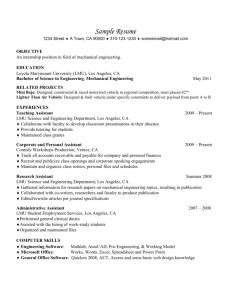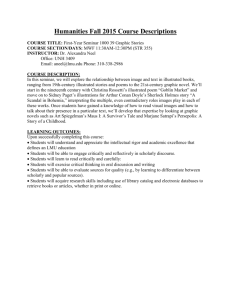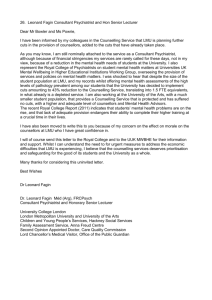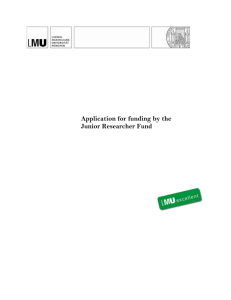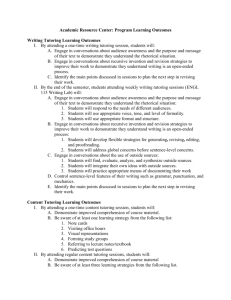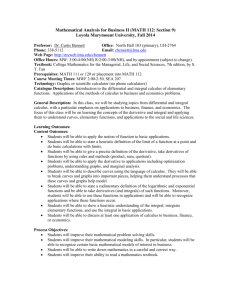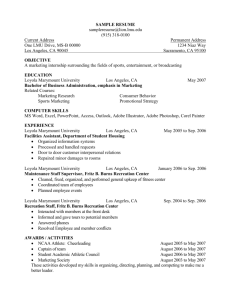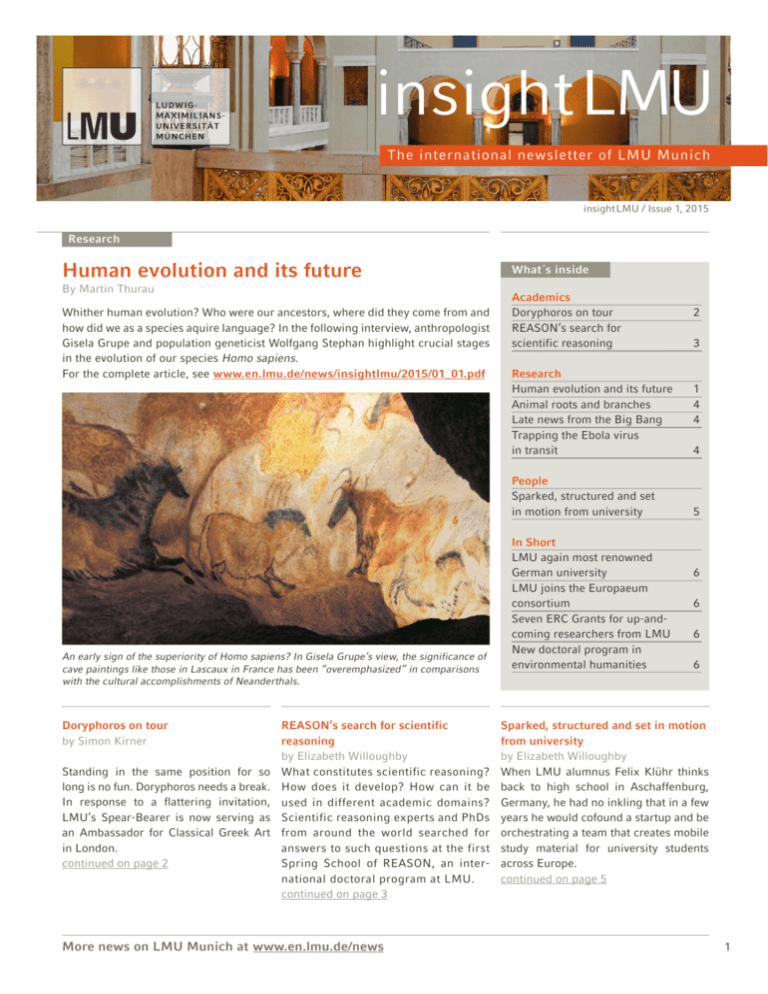
insight LMU
The international newsletter of LMU Munich
insight LMU / Issue 1, 2015
Research
Human evolution and its future
By Martin Thurau
Whither human evolution? Who were our ancestors, where did they come from and
how did we as a species aquire language? In the following interview, anthropologist
Gisela Grupe and population geneticist Wolfgang Stephan highlight crucial stages
in the evolution of our species Homo sapiens.
For the complete article, see www.en.lmu.de/news/insightlmu/2015/01_01.pdf
What´s inside
Academics
Doryphoros on tour REASON’s search for
scientific reasoning
Research
Human evolution and its future
Animal roots and branches
Late news from the Big Bang
Trapping the Ebola virus
in transit
People
Sparked, structured and set
in motion from university
An early sign of the superiority of Homo sapiens? In Gisela Grupe’s view, the significance of
cave paintings like those in Lascaux in France has been “overemphasized” in comparisons
with the cultural accomplishments of Neanderthals.
Doryphoros on tour
by Simon Kirner
Standing in the same position for so
long is no fun. Doryphoros needs a break.
In response to a flattering invitation,
LMU’s Spear-Bearer is now serving as
an Ambassador for Classical Greek Art
in London.
continued on page 2
REASON’s search for scientific
reasoning
by Elizabeth Willoughby
What constitutes scientific reasoning?
How does it develop? How can it be
used in different academic domains?
Scientific reasoning experts and PhDs
from around the world searched for
answers to such questions at the first
Spring School of REASON, an international doctoral program at LMU.
continued on page 3
More news on LMU Munich at www.en.lmu.de/news
2
3
1
4
4
4
5
In Short
LMU again most renowned
German university
6
LMU joins the Europaeum
consortium6
Seven ERC Grants for up-andcoming researchers from LMU 6
New doctoral program in
environmental humanities 6
Sparked, structured and set in motion
from university
by Elizabeth Willoughby
When LMU alumnus Felix Klühr thinks
back to high school in Aschaffenburg,
Germany, he had no inkling that in a few
years he would cofound a startup and be
orchestrating a team that creates mobile
study material for university students
across Europe.
continued on page 5
1
Academics
insight LMU / Issue 1, 2015
Doryphoros on tour
by Simon Kirner
Standing in the same position for so long is no fun.
Doryphoros needs a break. In response to a flattering
invitation, LMU’s Spear-Bearer is now serving as an
Ambassador for Classical Greek Art in London.
Choosing to reject a courteous request
from Prada is not a decision that is taken
lightly, especially when one is being
asked to open the Fondazione Prada’s
new art gallery in Milan. Indeed, the response would have been prompt and
positive – were it not for the fact that
an e-mail had arrived in Professor Rolf
Michael Schneider’s mailbox a short
time before. Addressed to the LMU archaeologist, Ian Jenkins, Senior Curator
in the Department of Greek and Roman
Antiquities at the British Museum in
London, politely enquired whether
LMU would be willing to lend its SpearBearer for an exhibition entitled Defining Beauty – The Body in Ancient Greek
Art, which opened in March 2015. “For
the first time, our bronze reconstruction is at the center of an exhibition – in
the British Museum – and will stimulate
renewed critical discussion. That’s what
set the project in motion in the spring of
2014,” says Schneider, who taught at
Cambridge University for several years.
Copies as pointers to the original
Polyklet’s statue of Doryphoros – the
Greek word for spear-bearer – is one of
the most famous bronzes created in
Classical Greece. Unfortunately, it is
known only from Roman copies, all
carved in marble. The original has not
survived. And this brings us to one
unique feature of LMU‘s Spear-Bearer
that explains why the British Museum
was interested in presenting it in their
current exhibition: This statue is the
result of an attempt to reconstruct
LMU‘s Spear-Bearer – the sculptural centerpiece of LMU‘s Main Building
– is being transported to London.
Polyklet’s original work, as faithfully as
possible, on the basis of existing Roman
copies – a method pioneered by Adolf
Furtwängler in the 19th century, which
is still in use today. Furtwängler was
Professor of Classical Archaeology at
LMU between 1894 and 1907. “Those
years were an exciting period for my
aca­demic forerunners,” says Schneider.
“At that time, it was widely believed
that lost original works of art from the
Classical Age could be reconstructed.
Of course, the idea of viewing antique
copies as guides to the originals was,
and still is, helpful. But in the end it
teaches us more about the Roman copies
themselves than it does about their lost
Greek archetypes.“
A chequered history
in the very heart of the Main Building.
“This illustrates how susceptible to misuse such a figure can become when it is
detached from its original context,”
says Schneider. “Then the Nazis appeared on the scene, although they had
little use for the piece.” And when the
central section of the Main Building was
destroyed in 1944, the Spear-Bearer
miraculously survived.
He survived, but not entirely unscathed,
having lost his lower legs, his eyes – and
his spear. He was returned to his original
position only in the mid-1950s, and has
taken on several new identities since
then. He now appears unarmed, and
constitutes the sculptural centerpiece of
the Main Building. So his absence, while
engaged in embodying a particularly
ambitious attempt to reimagine a lost
masterpiece of Classical Greek art for
visitors to the British Museum’s exhibition (which runs until 5 July), can hardly
go unnoticed. “He is a focal element in
the exhibition, with an original sculpture from the Western Pediment of the
Parthenon by his side,” says Schneider.
As soon as he returns from his stay in
London, Doryphoros will give us an account of his journey, which will appear in
MUM (the Münchner UniMagazin) and
online. Then he will resume his customary
station in the Main Building as a silent
observer of the comings and goings at
LMU.
Translation: Paul Hardy
“Even today, the figure of the SpearBearer retains a considerable measure
of cultural significance for LMU,” says
Schneider. “Its most interesting aspect
lies in the transformations that have occurred in how the figure is perceived.”
Over the past 100 years or so, it has been
part of an era that could hardly have
been more turbulent. Doryphoros’ bi­og­
raphy began with Adolf Furtwängler’s
researches, carried out in the intellectual atmosphere of LMU towards the
end of the 19th century. In 1921, it
found itself in a very different world,
serving as the focal point of a monument to the LMU academics and students who lost their lives in the First http://www.britishmuseum.org/whats
World War. That memorial was located _on/exhibitions/defining_beauty.aspx
2
Academics
insight LMU / Issue 1, 2015
REASON’s search
for scientific reasoning
by Elizabeth Willoughby
What constitutes scientific reasoning? How does it
develop? How can it be used in different academic
domains? Scientific reasoning experts and PhDs
from around the world searched for answers to such
questions at the first Spring School of REASON, an PhD students from all around the world shared their research data with each
other and obtained helpful feedback at the first REASON Spring School.
international doctoral program at LMU.
Central to the projects of all REASON
PhD students is being able to measure
scientific reasoning. Thus, this was the
theme for last month’s REASON Spring
School, where 45 PhD students from
Asia, the US and Europe were invited to
Munich for three days to share research,
refine measuring methodologies, and
participate in workshops offered by professors that are internationally renowned
for their work on scientific reasoning
and argumentation.
lish language instruction, 12 professors
from Munich’s LMU, Technical University and Catholic University of Applied
Sciences, who work in different areas of
scientific reasoning, support 20 doctoral
students via supervisory meetings, plenary discussions and presentations, and
informal meetings to discuss things like
defining scientific reasoning, its development and implementation. What role
does emotion play? How do children
process scientific evidence, and how do
medical students compared to math stuAndras Csanadi, a Hungarian PhD stu- dents? How do search engines, social
dent in his second year at the REASON media, and other technologies change
study program, found the event particu- scientific reasoning and argumentation?
larly valuable to his research, which is a
study on how student teachers engage Spring School success
in scientific reasoning in their everyday
practice, and how it can be fostered. Besides understanding what makes spe“We received a lot of feedback on our cific domains different, the overarching
research at the conference, which defi- aim is to find commonalities between
nitely contributes to a better quality of them. If a teacher who is helping a student
our theses,” he says. “An international with learning difficulties doesn’t use her
environment also inspires one to think psychology training, such as motivational
out of the box.” As well, the event pro- theories and memory models, then the
vided the opportunity for students to child’s real problem will not be adecreate new contacts, including with ex- quately addressed or resolved. But what
perts whose work they may have read if the teacher’s education curricula had
but whom they’d never met before.
included more effective support for scientific reasoning?
The graduate study program
Scientific reasoning could similarly be
REASON falls under the Munich Center included in medical education curricula
of the Learning Sciences (MCLS) and is and other domains, which is why the PhD
funded by the Elite Network of Bavaria. students researching different areas of
Under the direction of Prof. Frank Fischer scientific reasoning participate in comand coordinator Dr. Marcus Bozer, in Eng­ mon activities.
Says Andras, “Working in an interdisciplinary team helps to keep your mind
open by taking you out of your spe­ciali­
za­tion. What I also really like is that we
are constantly developing not only our
work but our way that we deal with
problems and with each other.”
REASON PhD student Maryam Alqassab
from Bahrain, one of the organizers of the
Spring School, says the inter­dis­ci­plin­ary
aspect and expert feedback of the study
program is a PhD student’s dream, but the
Spring School was par­ticu­larly rewarding.
“I wanted to be part of the organization
committee because I felt it would be a great
opportunity to cooperate with so many
different people. We had to make sure PhD
students from around the world would
attend. We had to recruit acknowledged
professors and experts in scientific reasoning. We had to collaborate with peers
and professors to be sure that the conference would be a useful and rich learning experience for all participants, who
were coming from many different fields
but all sharing the same research interest.”
“We met all our goals for the conference,” says Andras, “and students found
the feedback, workshops and keynote
presentations very helpful. What really
surprised me, though, was the number
of common aspects that exist between the
different topics and my own research.
For me it was a great collaboration.”
www.en.mcls.lmu.de/study_programs/
reason/
3
Research
insight LMU / Issue 1, 2015
Geobiology
Pharmacology
Animal roots and branches
Trapping the Ebola virus in
transit
By Martin Thurau
Sponges are one of the most ancient of all extant animal lineages. LMU geobiologist
Gert Wörheide studies the group to learn about early animal evolution and how new
species evolve.
For the complete article, see www.en.lmu.de/news/insightlmu/2015/01_02.pdf
Cosmology
Late news from the Big Bang
What exactly happened after the Universe
was born? Why did stars, planets and
huge galaxies form? These are the questions that concern Viatcheslav Mukhanov,
who models the first instants after the
creation of our Universe and tries to find
the answers with the help of mathematical
physics. Mukhanov, Professor of Physics
at LMU, is an acknowledged expert in the
field of Theoretical Cosmology. He has
used the notion of so-called quantum
fluctuations to construct a theory that
provides a precise picture of the crucial
initial phase of the evolution of our Universe: For without the minimal variations
in energy density that result from the tiny
but unavoidable quantum fluctuations,
one cannot account for the formation of
stars, planets and galaxies that characterize the Universe we observe today.
The Planck Consortium has now published new analyses of data returned by
the eponymous space telescope. The
Data have now confirmed beyond any
reasonable doubt Mukhanov’s theory of
the quantum origin of structure in the
Universe. The telescope on board of the
Planck satellite has measured the distribution of the cosmic microwave background radiation, which, in essence,
tells us what the Universe looked like
about 400,000 years after the Big Bang.
These latest findings are in complete
agreement with the predictions of
Mukhanov’s theory – for example, his
calculation of the value of the so-called
spectral index of the initial inhomo­
geneities. As Jean-Loup Puget, Principal
Investigator for the HFI-instrument on
the Planck satellite, stated: “The Planck
data confirm the basic predictions that
quantum fluctuations are at the origin of
all structures in the Universe.” Muk­ha­nov,
who first published his model in 1981
and joined the Physics Faculty at LMU in
1997, says “I couldn’t hope for a better
verification of my theory.”
How the Ebola virus infects host cells
and exploits their metabolism for the
production of new virus particles is not
fully understood. Research groups led
by pharmacologists Martin Biel and
Christian Wahl at LMU, and virologist Dr.
Robert Davey at the Texas Biomedical
Research Institute have now supplied one
of the missing pieces of the puzzle – and
uncovered a new target for therapeutic
drugs. The Ebola virus infects macrophages by latching onto specific receptor molecules found on their surfaces.
Receptor binding causes the cell membrane to fold inwards like a pouch which
is then pinched off, engulfing the receptors and the attached viruses in endocytic
vesicles. These “endosomes” then fuse
with another type of vesicles called lysosomes. Specific ion-channel proteins in
the lysosomal membrane, known as twopore channels (TPCs), are known to play
an important role in the fusion process.
Biel and his team have now shown that
TPCs are essential for the establishment
of an Ebola infection: Upon binding of
an endosome, the TPCs release a stream
of calcium ions into the cytoplasm that
serves as a signal for membrane fusion,
which is required to ensure that Ebola
infection cycle can proceed. If the TPCs
are genetically defective or functionally
inhibited, the viruses remain trapped in
the endosomes, effectively aborting the
infection. The researchers also found that
tetrandrine, an alkaloid derived from plants
used in traditional Chinese medicine, effectively inhibits infection of isolated
macrophages by the Ebola virus. Biel and
his colleagues took a closer look at the
interaction between tetrandrine and TPCs
and analyzed its effect on their function.
Martin Biel believes that targeting the
TPCs represents a promising strategy.
“Instead of trying to kill the virus, we simply ensure that it is no longer infectious”.
4
People
insight LMU / Issue 1, 2015
Sparked, structured and
set in motion from university
by Elizabeth Willoughby
When LMU alumnus Felix Klühr thinks back to high
school in Aschaffenburg, Germany, he had no inkling
that in a few years he would cofound a startup and be
orchestrating a team that creates mobile study material
for university students across Europe.
Playing soccer for balance and cooking
to relax, Felix was unsure of what profession he eventually wanted, so he
postponed university and left Germany
to work, travel and gain some experience.
After completing an internship in New
York city evaluating the profitability of
airline routes, and working in a hotel in
Tenerife, Canary Islands, he found himself highly motivated to get on with his
studies. Felix decided to take business
administration at LMU because of the
university’s excellent reputation and location, and describes his four years
there as the perfect combination of freedom, social interaction and academic
education.
from tailored materials to study. Their
successful exam results were noticed by
other students, who began to pressure
them to share their methods and material.
Influenced by his course on business
planning and with input from his macroeconomics Professor Flaig, Felix brainstormed with his two peers about the
best way to distribute the study materials
among the students as a complimentary
tool to exam preparation. After some
failed attempts, they decided that a mobile app would be the best way. It would
also allow students to study wherever
and whenever they wanted to.
Groundwork for growth
“Studying at university is the greatest
time in life,” says Felix. “It is a period of
freedom from responsibilities that you
will probably never experience again,
which allows you to do and to learn so
much, and it’s those moments and relationships that shape your personality.”
Unlike in some universities where students lose grades for missing classes, in
business administration at LMU there is
a three-week study period followed by
all the exams, twice a year. “Other than
those six weeks,” says Felix, “that gives
you so much freedom in the way you
allocate your time. If you manage your
The spark
studies properly, you can work, you can
LMU is also where he and two fellow have a side project, you can do whatever
students got a big idea. In their third you want.”
semester, Felix, Korbinian Weisser and
Jonas Hoffmann developed their own Thus began Felix and his partners’ steep
study materials to prepare for upcoming learning curve of the development of a
exams, which were increasingly being startup and mobile app that would give
given in a multiple choice format. Rather practice questions created by top stuthan paying for expensive tutors or using dents (called tutors) for specific course
the existing summarized study material, studies. They called it qLearning – q for
the three created a pool of questions taken quick. The startup not only provided a
way for them to stand out from the other
800 plus LMU business students, but the
external validation would also be important for future professional prospects.
The big breakthrough near the end of
their studies came from Hub:raum, the
incubator of Deutsche Telekom (DTAG),
who invited Felix and his partners to
move into their newly built offices in
Berlin with full support for a year. They
also offered the initial seed funding to
develop the app. It didn’t take them long
to accept the offer.
18 months later, qLearning now has 275
tutors at 100 universities across Europe,
and in 2014, 60,000 students were using
the app for exam preparation, but Felix
wants to take it further. He wants to see
it used by university students across the
globe, as well as by professors to provide
a more blended learning experience,
and to contribute to the content. It is
catching on, even outside of Europe – a
professor at Queens School of Business in
Kingston, Ontario in Canada has started
to use qLearning as a teaching tool.
“I love ideas,” says Felix. “I love the execution of ideas. I want to get things
done.”
https://www.qlearning.de
5
In Short
LMU again most renowned
German university
The Times Higher Education World Repu­
tation Rankings 2015 place LMU Munich
in 35th slot overall, making it again the
best performer among the German universities listed. LMU has improved its
position by 11 places over the course of
the past year, and is again ranked among
the top ten in Europe. As part of the survey on which the Times Higher Education
World Reputation Rankings 2015 are
based, the THE, in cooperation with scientific publisher Elsevier, last year asked
renowned academics in all fields to
name the universities they regarded as
the best in their own particular discipline. Some 10,500 respondents in 142
countries contributed to the exercise.
www.thewur.com
LMU joins the Europaeum
consortium
LMU is now a member of the Europaeum,
an association of 11 leading European
universities founded in 1992 with the intention of promoting excellence in research and teaching, specifically in the
field of European Studies. The Europaeum
counts Oxford University, the Université
Paris – Panthéon-Sorbonne, the Universidad Complutense de Madrid and
Charles University in Prague among its
members. LMU is currently the only
German university in the network. The
Europaeum’s activities include organizing
collaborative courses, summer schools
and Master’s programmes, arranging interdisciplinary conferences and workshops, facilitating research visits, and
opening fellowship schemes and mobility
programs to applicants from the partner
universities. The Europaeum’s major research focus is on the field of European
Studies, and its primary goal is to develop
a pool of talents – a group of gifted
scholars who will carry out collaborative
insight LMU / Issue 1, 2015
investigations of specifically European
topics. In addition, the Europaeum seeks
to promote cooperation between its
member institutions, to stimulate dialog
between academic researchers and the
spheres of politics, commerce, the media
and culture, and to train future European
political and business leaders.
www.europaeum.org
Seven ERC Grants for
up-and-coming researchers
from LMU
In the latest call for proposals for Starting
Independent Researcher Grants issued
by the European Research Council (ERC),
submissions from LMU researchers
have won six of the generously endowed
awards, more than any other university
in Germany. Moreover, a LMU physicist
has obtained an ERC Consolidator Grant,
worth 2 million euros. ERC Starting
Grants aim to support up-and-coming
researchers from all over the world who
are about to establish or consolidate a
proper research team and to start conducting independent research in Europe,
whereas the Council’s Consolidator Grants
enable gifted young scientists who have
already published innovative work to extend their investigations further. ERC
grants are awarded solely on the basis of
the scientific excellence of the researcher and the research proposal. The LMU
Starting Grant awardees in this latest
round are: Dr. Martin Saxer (Faculty of
Cultural Studies), Dr. Christoph Scheiermann (Faculty of Medicine), Dr. Alexander Fraser (Faculty of Languages and
Literatures), Dr. Franz Herzog (Faculty
of Chemistry and Pharmacy) and Prof.
Bernadett Weinzierl (Faculty of Physics).
Philosopher Dr. Barbara Osimani is
moving to LMU, and will carry out her
ERC project at the Munich Center for
Mathematical Philosophy. The ERC has
awarded a Consolidator Grants to LMU
physicist Dr. Peter Baum.
Any questions or comments? insight@lmu.de
New doctoral program in
environmental humanities
The social repercussions of climate
change and loss of biodiversity, the
domination and destruction of natural
resources and habitats as well as problems of environmental justice: these are
among the topics dealt with in the new
doctoral program designed by LMU’s
Rachel Carson Center – in collaboration
with the University of Leeds (UK) and the
Environmental Humanities Lab at the
Royal Institute of Technology in Stockholm. The network will give suitably
qualified graduate students the opportunity to become intimately acquainted
with all facets of the environmental humanities. The project “Environmental
Humanities for a Concerned Europe”
(ENHANCE for short) is the first distinctively transnational and multidisciplinary
educational and research endeavor of its
kind in this area. The program is made
possible by a € 3 million grant from the
European Commission‘s Marie Curie Actions Initiative. These European-funded
positions begin 1 October 2015. The
deadline for applications for the LMU
Munich positions is 15 Mai 2015.
www.carsoncenter.lmu.de/
study/enhance
Imprint
Published by the Executive Board of
Ludwig-Maximilians-Universität München
Luise Dirscherl (editor in chief)
Dr. Kathrin Bilgeri (executive editor)
Communications & Media Relations
Layout: Christine Meyer Design München
Picture Credits: picture alliance/
Bild­agentur-online (p. 1), Roy Hessing
(p. 2/ left); Michael Strauch/LMU (p. 2/
right), REASON/LMU (p. 3), Wörheide/
LMU (p. 4), Felix Klühr (p. 5).
© All rights reserved by
Ludwig-Maximilians-Universität München
6


